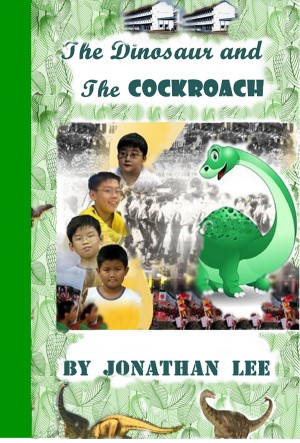Location: Singapore
Member Since:
Oct. 11, 2015
1 reader has added this author as a 'Favorite Author'.
Jonathan Lee
Biography
I grew up believing that Singapore history starts with Sir Stamford Raffles. That is the official narrative. But I think there is more than meets the eye. There is a hidden history.
My writing journey started with a short story : Dinosaur and the Cockroach -- a metaphor for the evolution of politics and leadership approach in Singapore, written at a time when communism was on its death throes and Catholic "activists" were jailed for communist activities. The short story was described as a "political parody". Since then, I have written several short stories. The Lion City is a veiled commentary on gender politics dressed up in the founding legend of Singapura. It begs the question : who benefits from polygamy, and which will make our society stronger : monogamy or polygamy? Sex Lies and Videotape is about sexual relations within a marriage. It begs the question what is the relative merits of nature vs nurture in sexual relations. The Kent Ridge Caper is about gender relationship, and how society tries to calibrate sex into that relationship.
Escape to Temasek and Fall of Singapura are my current passion. I have researched, written and edited this two novels for the past five years. It has spawned a documentary film (Hunt for the Red Lion). And I am still researching other aspects of Singapore history. These two novels rub against the grain of Singapore society. It is a re-interpretation of Singapore history. Most of my friends asked : Are these two novels credible? Were there people in Singapore before Stamford Raffles arrived? Were there Chinese in Singapore at that time? Was the lion really red? Was there really a pirate army? Who attacked Palembang? Was there any connection between the boy hero and the death of a princess? Was she really impaled on a public square? Who attacked Singapura? Was it a Majapahit army or a Tai army? And what happened on Forbidden Hill? To answer these questions, I have compiled two Historical Analysis available on my website (www.jonathanleebooks.com).
My message for you, the reader : just sit back and enjoy a good read.
The important point is : Singapore had a history, where none existed before.
Jonathan Lee
My writing journey started with a short story : Dinosaur and the Cockroach -- a metaphor for the evolution of politics and leadership approach in Singapore, written at a time when communism was on its death throes and Catholic "activists" were jailed for communist activities. The short story was described as a "political parody". Since then, I have written several short stories. The Lion City is a veiled commentary on gender politics dressed up in the founding legend of Singapura. It begs the question : who benefits from polygamy, and which will make our society stronger : monogamy or polygamy? Sex Lies and Videotape is about sexual relations within a marriage. It begs the question what is the relative merits of nature vs nurture in sexual relations. The Kent Ridge Caper is about gender relationship, and how society tries to calibrate sex into that relationship.
Escape to Temasek and Fall of Singapura are my current passion. I have researched, written and edited this two novels for the past five years. It has spawned a documentary film (Hunt for the Red Lion). And I am still researching other aspects of Singapore history. These two novels rub against the grain of Singapore society. It is a re-interpretation of Singapore history. Most of my friends asked : Are these two novels credible? Were there people in Singapore before Stamford Raffles arrived? Were there Chinese in Singapore at that time? Was the lion really red? Was there really a pirate army? Who attacked Palembang? Was there any connection between the boy hero and the death of a princess? Was she really impaled on a public square? Who attacked Singapura? Was it a Majapahit army or a Tai army? And what happened on Forbidden Hill? To answer these questions, I have compiled two Historical Analysis available on my website (www.jonathanleebooks.com).
My message for you, the reader : just sit back and enjoy a good read.
The important point is : Singapore had a history, where none existed before.
Jonathan Lee
Smashwords Interview
Where to find Jonathan Lee online
Videos
HUNT FOR THE RED LION
An ancient prince (SNU) stumbled onto an island, saw an animal with red body, black head, and white belly, with the size of a he-goat. When told that this animal was a lion, he named this island Singapura (a Lion City). And this was how Singapore derived its name. But where in the world can you find a lion (or any animal) with such colours? This means that there is more than meets the eye ... watch this investigative documentary film for answers that will surprise even Singaporeans.
Jonathanlee Video
Where does Jonathanlee and his stories come from? This video will give you a glimpse into the thinking behind his stories : Escape to Temasek, Fall of Singapura, Sex Lies and Videotape, Kent Ridge Capers, King's Madness, Dinosaur and Cockroach
Jonathanlee Video
Books
The Dinosaur and the Cockroach
by Jonathan Lee
Price:
Free!
Words: 8,160.
Language:
English.
Published: April 2, 2016
.
Categories:
Fiction » Young adult or teen » Social Issues
Trials and tribulation that points us to social challenges, leadership change and ultimately political development. This is a story about five schoolboys. It is also a story about the health of a Singapore polity.
The King's Madness
by Jonathan Lee
Price:
Free!
Words: 7,550.
Language:
English.
Published: April 2, 2016
.
Categories:
Fiction » Historical » Ancient, Fiction » Fantasy » Short stories
The is an alternative narrative of a little lion cub's notion of justice, equality, love, and ... polygamy.
Jonathan Lee's tag cloud
Jonathan Lee's favorite authors on Smashwords
Smashwords book reviews by Jonathan Lee
-
Whisky Tango Foxtrot...Copy?
on July 22, 2016
(no rating)
I was captivated by the breadth of this novel from navy cadet to politics to civil rights demonstrators to government corruption to CIA conspiracies, all seen through the eyes of a bizarre accident-capsize-at-sea survivor. This is the first novel I have read set in Australia and I found the Australian manner of speech and relationships fascinating. After enjoying the novel so much, I found the ending somewhat sudden and shocking. I wish the ending could have more tension, more build-up and more drama so that I can reach a satisfying conclusion to what was a fantastic read.



